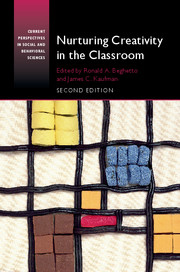Book contents
- Frontmatter
- Dedication
- Contents
- Preface
- Acknowledgments
- PART I VOICES FROM THE FIELD
- PART II VOICES FROM THE RESEARCH
- 5 Developing Creativity Across All Areas of the Curriculum
- 6 Accountability, the Common Core, and Creativity
- 7 Ever-Broadening Conceptions of Creativity in the Classroom
- 8 Creativity in Mathematics Teaching: A Chinese Perspective (An Update)
- 9 Roads Not Taken, New Roads to Take: Looking for Creativity in the Classroom
- 10 The Five Core Attitudes and Seven I's of the Creative Process
- 11 Creativity Embedded into K–12 Teacher Preparation and Beyond
- 12 Attitude Change as the Precursor to Creativity Enhancement
- 13 Nurturing Creativity in the Engineering Classroom
- 14 Intrinsic Motivation and Creativity in the Classroom: Have We Come Full Circle?
- 15 Learning for Creativity
- 16 Creativity and Prosocial Values: Nurturing Cooperation within the Classroom
- 17 How Social-Emotional Imagination Facilitates Deep Learning and Creativity in the Classroom
- 18 Four Faces of Creativity at School
- 19 Teaching for Creativity
- 20 A Coda for Creativity in the Classroom: Take-Home Points and Final Insights
- Index
- References
19 - Teaching for Creativity
from PART II - VOICES FROM THE RESEARCH
Published online by Cambridge University Press: 24 November 2016
- Frontmatter
- Dedication
- Contents
- Preface
- Acknowledgments
- PART I VOICES FROM THE FIELD
- PART II VOICES FROM THE RESEARCH
- 5 Developing Creativity Across All Areas of the Curriculum
- 6 Accountability, the Common Core, and Creativity
- 7 Ever-Broadening Conceptions of Creativity in the Classroom
- 8 Creativity in Mathematics Teaching: A Chinese Perspective (An Update)
- 9 Roads Not Taken, New Roads to Take: Looking for Creativity in the Classroom
- 10 The Five Core Attitudes and Seven I's of the Creative Process
- 11 Creativity Embedded into K–12 Teacher Preparation and Beyond
- 12 Attitude Change as the Precursor to Creativity Enhancement
- 13 Nurturing Creativity in the Engineering Classroom
- 14 Intrinsic Motivation and Creativity in the Classroom: Have We Come Full Circle?
- 15 Learning for Creativity
- 16 Creativity and Prosocial Values: Nurturing Cooperation within the Classroom
- 17 How Social-Emotional Imagination Facilitates Deep Learning and Creativity in the Classroom
- 18 Four Faces of Creativity at School
- 19 Teaching for Creativity
- 20 A Coda for Creativity in the Classroom: Take-Home Points and Final Insights
- Index
- References
Summary
What Is Creativity?
Creativity is a habit (Sternberg, 2006; Tharp, 2005). Habits can be good or bad. My four-year-old daughter Brittany sucks her thumb: That's a bad habit. Creativity, however, is a good habit. The problem is that schools sometimes treat it as a bad habit (Craft, 2005), of the order of sucking one's thumb. And the world of conventional standardized tests we have invented does just that (Sternberg, 1997b; 2010a; Sternberg, Jarvin, & Grigorenko, 2011). If students try being creative on standardized tests, they will get slapped down just as soon as they get their score. That will teach them not to do it again.
Oddly enough, a distinguished psychometric tester, J. P. Guilford, was one of the first to try to incorporate creativity into the school curriculum (Guilford, 1950), but his efforts show little fruit today, although more and more educators recognize the importance of teaching for creativity (Plucker & Beghetto, 2015; Reis & Renzulli, 2014). Disciples of Guilford such as MacKinnon (1962) and Torrance (1962) had little more success, although again, there are signs that their efforts may yet bear fruit.
It may sound paradoxical that creativity – a novel response – is a habit – a routine response. But creative people are creative largely not as a result of any particular inborn trait, but rather through an attitude toward life (Maslow, 1967; Schank, 1988): They habitually respond to problems in fresh and novel ways, rather than allowing themselves to respond mindlessly and automatically (Sternberg, 2010c; 2013b; Sternberg & Lubart, 1992, 1995a, 1995b, 1995c).
Like any habit, creativity can either be encouraged or discouraged. The main things that promote the habit are (1) opportunities to engage in it, (2) encouragement when people avail themselves of these opportunities, and (3) rewards when people respond to such encouragement and think and behave creatively. You need all three. Take away the opportunities, encouragement, or rewards, and you will take away the creativity. In this respect, creativity is no different from any other habit, good or bad.
- Type
- Chapter
- Information
- Nurturing Creativity in the Classroom , pp. 355 - 380Publisher: Cambridge University PressPrint publication year: 2016
References
- 4
- Cited by

